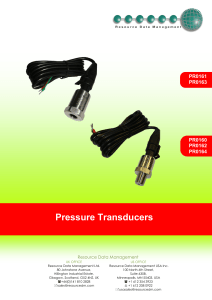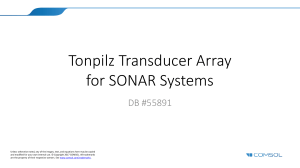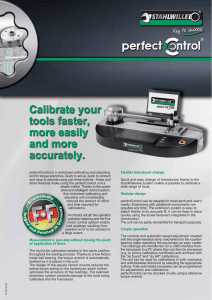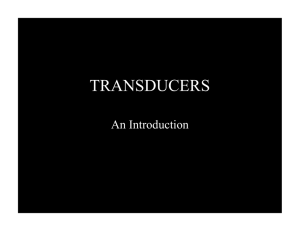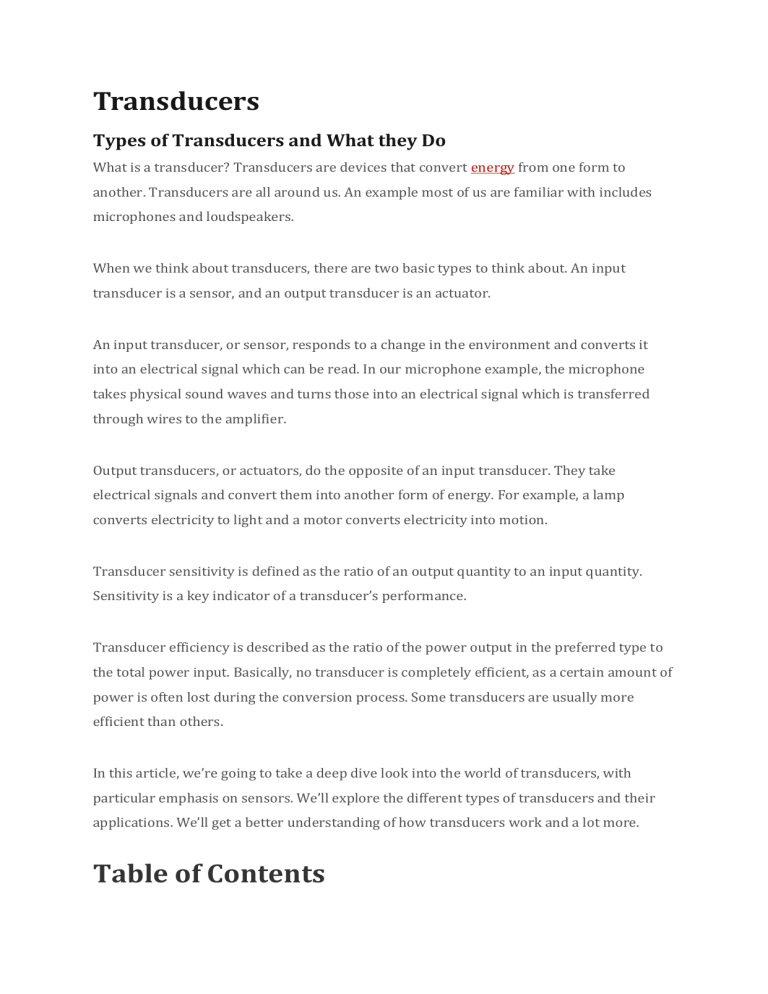
Transducers Types of Transducers and What they Do What is a transducer? Transducers are devices that convert energy from one form to another. Transducers are all around us. An example most of us are familiar with includes microphones and loudspeakers. When we think about transducers, there are two basic types to think about. An input transducer is a sensor, and an output transducer is an actuator. An input transducer, or sensor, responds to a change in the environment and converts it into an electrical signal which can be read. In our microphone example, the microphone takes physical sound waves and turns those into an electrical signal which is transferred through wires to the amplifier. Output transducers, or actuators, do the opposite of an input transducer. They take electrical signals and convert them into another form of energy. For example, a lamp converts electricity to light and a motor converts electricity into motion. Transducer sensitivity is defined as the ratio of an output quantity to an input quantity. Sensitivity is a key indicator of a transducer’s performance. Transducer efficiency is described as the ratio of the power output in the preferred type to the total power input. Basically, no transducer is completely efficient, as a certain amount of power is often lost during the conversion process. Some transducers are usually more efficient than others. In this article, we’re going to take a deep dive look into the world of transducers, with particular emphasis on sensors. We’ll explore the different types of transducers and their applications. We’ll get a better understanding of how transducers work and a lot more. Table of Contents What is a Transducer Used For? How Many Types of Transducers are There? What is an Example of a Transducer? What is the Difference Between a Sensor and Transducer? What are the Main Parts of a Transducer? How do you Calibrate a Transducer? How do you Test a Transducer? What is the Difference between Active and Passive Transducers? What is the Difference Between a Current Transformer and a Current Transducer? How Does a Current Transducer Work? What is the Output of a Current Transducer? What is Signal Conditioning in a Transducer? What are the Applications of a Hall Effect Transducer? Conclusion What is a Transducer Used For? A transducer converts energy from one sort to another. Generally, transducers convert one type of energy, for example, mechanical or magnetic, into something you can measure on the other end, an electrical signal. You can also go the other way as well and convert an electrical signal into something else, like a mechanical movement. How Many Types of Transducers are There? Lots! Almost too many to mention. We’ve mentioned some above – current transducers, magnetic field transducers, voltage transducers. Microphones, speakers, thermocouples. Antenna transmitters and receivers are also transducers. Current transducers Current transducers are used when going from a primary current source to a secondary signal output that we can measure. Magnetic field transducers Magnetic Field Transducers are used when going from a magnetic field source to a signal out that we can measure. Pressure transducers Pressure Transducers or force transducers and convert physical force into a number or reading that can be measured and understood. These are also referred to as a load cell. A piezoelectric transducer A Piezoelectric Transducer converts the electrical charges produced by some forms of solid materials into energy. Piezoelectric transducers use the word “piezoelectric” as it literally means electricity caused by pressure. Thermocouples Thermocouples which are like electronic thermometers measure voltage changes and prevent our phones, thermostats, and cars from overheating. An Electromechanical transducer An electromechanical Transducer is any type of device that either converts electrical signals into sound waves (as in a loudspeaker) or converts a sound wave into an electrical signal (as in the microphone). Mutual induction transducers Mutual Induction Transducers rely on two coils for mutual induction. One for generating excitation and another for output. Strain gauges Strain Gauges are types of transducers that convert a physical quantity such as a load, pressure, or displacement into mechanical strain on the strain generating body. The strain is converted into electrical output using mounted strain gauges. Current Transducers and Sensors LEARN MORE What is an Example of a Transducer? Let’s use an example of the thing we all use the most every day – our phones. Every phone has a microphone and speaker. There are accelerometers to measure the movement of the phone for those who like counting daily steps. Electronic compasses. Gyroscopes. Those are all input transducers (sensors). The actuator that causes your phone to vibrate when you put it on silent – that’s an output transducer (actuators). And if that’s not enough, every pixel on your screen is actually a transducer. As you can see, transducers are basically everywhere. Some more examples of transducers can be found in your car. Pretty much everything on your dashboard originates from a transducer. Your speedometer converts the rotational speed of your wheels into miles per hour. Tachometers generally have a Hall effect sensor that sends an electronic signal for every rotation of the engine. Thermocouples measure engine temperature, cabin temperature, and outside temperature. Pressure sensors measure your oil pressure and detect changes in tire pressure. Accelerometers to detect crashes and deploy airbags. The actuator motors for your seat adjustment are also transducers. What is the Difference Between a Sensor and Transducer? A transducer is broader and includes both sensors and actuators. A sensor specifically reacts to something in the environment – mechanical, electrical, temperature, pressure, and so on, and converts it to an electronic signal to be recorded or analyzed elsewhere. So generally, a sensor is a type of transducer. What are the Main Parts of a Transducer? When talking about sensor transducers, you have the sensor head, the part that reacts to change in the environment. The environmental change could be magnetic field (and remember, electric current moving through a conductor generates the surrounding magnetic field), temperature, pressure, and so on. You then need to convert that into a usable electric signal, so there is some sort of electronics involved. That could be something as simple as a resistor converting induced voltage to current and vice versa. It could also be an amplifier to strengthen a very small signal to something useful. Or even an integrator circuit to translate the rate of change in current into the actual underlying current waveform. AKM Currentier Current Sensors LEARN MORE How do you Calibrate a Transducer? Generally, you compare it to a reference. Either you have a known source, for example, a current source for a current transducer, and compare that to the output on the transducer, or you compare it to another reference transducer that’s been calibrated itself at, for example, a national standards laboratory. NIST (National Institute for Standards and Technology) is an example in the United States. How do you Test a Transducer? Testing a transducer is similar to calibrating but without the same rigor. You put it in a test environment that you know is changing, like moving a thermocouple from the shade to the sun, or even just holding it in your hand, to warm it up and see if it responds to how you act. For a magnetic field transducer, you can change the magnetic field, by example bringing it close to a permanent magnet, and see if the transducer output changes. For a current transducer, raise or lower the current and see if the output changes as you expect. What is the Difference between Active and Passive Transducers? An active transducer requires external power to generate a signal, which could be some sort of excitation, signal processing, integrator circuit, amplifier or other electronics. Most current transducers are active transducers. A passive transducer has a signal induced just by the inherent properties of whatever the transducer sensor detects. For example, a thermocouple generates a voltage based on a change in temperature, without requiring an external power source. What is the Difference Between a Current Transformer and a Current Transducer? A current transformer steps the current up or down from its source. It can be used for measuring current, with a lot of turns, for example, 1000 to 1 turns ratio. If you have a primary current of 1000 amps, your transfer will give you your current output of 1 amp, which is low enough you can probably measure it in your measurement instrument, perhaps converting to a voltage signal with a resistor. A transformer can also be reversed, taking a 1 amp source into a 1000 amp output. A transformer inherently is limited to AC current only, as it is detecting a change in the primary current. A current transducer on the other hand directly converts the energy into another type of energy. For example, electric current into a voltage output signal. That electrical output might then be converted back into a current, but there is some sort of intermediate stage where conversion takes place. The key point is some sort of conversion must take place. One inherent advantage of a current transducer over a transformer is that a transducer can measure DC currents as well as AC currents. DC Current Transducers LEARN MORE How Does a Current Transducer Work? It depends on the type you’re using. One type of current transducer is a Hall sensor, which converts the magnetic field that is given off by all current conductors into a voltage signal. The Hall sensor is isolated from the conductor — it doesn’t have to actually be in contact. Many current transducers, including some Hall effect ones mentioned previously as well as other types mentioned later, are “closed-loop” transducers. These current transducers have a magnetic core of some sort, that helps concentrate the field given off of the primary conductor, and help reject external magnetic fields from interfering with reliable measurements. They then have a secondary compensation coil wrapped around the core, further improving accuracy of the current transducer. The best performing DC current transducers (DCCT) are fluxgate types, with accuracies and stabilities that can be measured in the parts per million (ppm) range. In Hall effect current transducers, a Hall device is inserted in a gap of the magnetic core. The gap is subject to thermal expansion and mechanical stresses. In a fluxgate, there is no gap, eliminating these errors and dramatically improving performance. A zero flux fluxgate can measure dc current to sub-ppm (parts-per-million) level. Compare that to a Hall effect current transducer, which can measure DC current, but only at 1% or 0.1% accuracy. Sub-ppm means accuracy of better than 0.0001%. This relies on two principles found in the name – zero-flux and fluxgate. Zero flux means you actually have a compensation current to keep the magnetic core at zero magnetic flux, which avoids issues of saturation in the core, and measures the compensation current. The fluxgate actually energized the core with an AC signal, high precision measurements of the DC primary current. What is the Output of a Current Transducer? The output signal is either a voltage or current output, which is then input to your measurement instrument. That could be a datalogger, power analyzer, oscilloscope, or voltmeter. Or it could be used in an OEM application, for example as part of a feedback loop for an electromagnet control system or a highly stable power supply. What is Signal Conditioning in a Transducer? Signal conditioning is the technique of making a signal from a sensor or transducer suitable for processing by data acquisition equipment. For example, if you’re measuring a voltage signal smaller than a few millivolts, you might need to amplify it. If you had a signal contaminated with noise you could filter it. What are the Applications of a Hall effect Transducer? Hall effect elements are reactive to change in a magnetic field, generally having an induced voltage for a given magnetic field. The use cases are numerous. You can directly measure a magnetic field for example. This is a magnetic field transducer, with input of magnetic field (which can be single or multiple axis) and an output signal measured in volts. You can use a Hall effect sensor to measure electric current. You can use it to measure the position of something by putting a very small magnet on whatever it is, and then measuring the field off that magnet. You can use it to measure how fast an engine is turning. Conclusion You can now see that transducers are all around us. They make our lives more comfortable in countless ways. The more we’re able to measure with accuracy, the more we can get out of our products, designs, and equipment. In many ways, transducers make the comforts of modern civilization a reality.

